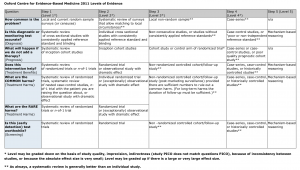Hierarchy of evidence
As previously mentioned the study type can be placed into a hierarchy of evidence, not quite top trumps style, but a theoretical order or hierarchy that the evidence can be considered to exist in. This order is useful to acknowledge but it is also important to understand that a hierarchy of studies containing some that are poorly thought out and executed loses its validity. In this section we run through hierarchy’s with particularly reference to the Oxford Levels of Evidence.
Some study types will be thought of as a higher level of evidence than other due to their study design.
Many will have heard of RCT’s or meta-analyses being the highest form of evidence and that we should look for these when trawling the literature. That’s great in theory but realistically they are big pieces of research to conduct, can take a huge amount of time, money and resources and often conditions are so infrequent as to not be feasible e.g. in Toxicology doing an RCT of intralipid for a rare presentation.
For that reason we need to be aware of the different levels of evidence, appreciate their strengths and weaknesses, but not ignore the utility of the range of evidence that exists.

The Oxford Levels of Evidence 2
Oxford Centre for Evidence-Based Medicine; Jeremy Howick, Iain Chalmers (James Lind Library), Paul Glasziou, Trish Greenhalgh, Carl Heneghan, Alessandro Liberati, Ivan Moschetti, Bob Phillips, Hazel Thornton, Olive Goddard and Mary Hodgkinson
This podcast covers
- Oxford levels of evidence
Once you’ve listened help consolidate the topics covered with the questions below.
